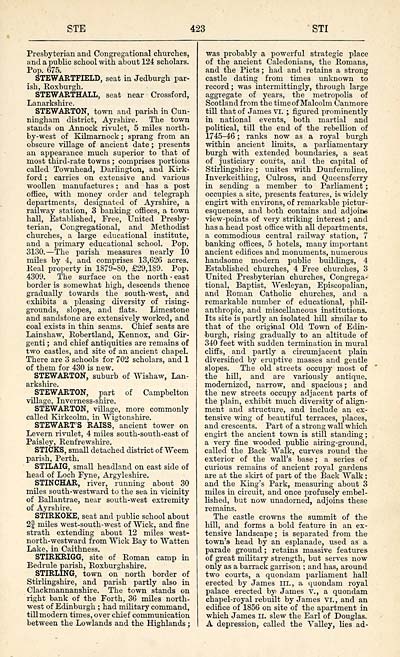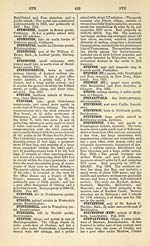Gazetteer of Scotland
(433) Page 423
Download files
Complete book:
Individual page:
Thumbnail gallery: Grid view | List view

STE
423
STI
Presbyterian and Congregational churches,
and a public school with about 124 scholars.
Pop. 675.
STEWARTFIELD, seat in Jedburgh par-
ish, Roxburgh.
STEWARTHALL, seat near Crossford,
Lanarkshire.
STEWARTON, town and parish in Cun-
ningham district, Ayrshire. The town
stands on Annock rivulet, 5 miles north-
by-west of Kilmarnock ; sprang from an
obscure village of ancient date ; presents
an appearance much superior to that of
most third-rate towns ; comprises portions
called Townhead, Darlington, and Kirk-
ford ; carries on extensive and various
woollen manufactures ; and has a post
office, with money order and telegraph
departments, designated of Ayrshire, a
railway station, 3 banking offices, a town
hall, Established, Free, United Presby-
terian, Congregational, and Methodist
churches, a large educational institute,
and a primary educational school. Pop.
3130. — The parish measures nearly 10
miles by 4, and comprises 13,626 acres.
Real property in 1879-80, £29,189. Pop.
4309. The surface on the north - east
border is somewhat high, descends thence
gradually towards the south-west, and
exhibits a pleasing diversity of rising-
grounds, slopes, and flats. Limestone
and sandstone are extensively worked, and
coal exists in thin seams. Chief seats are
Lainshaw, Robertland, Kennox, and Gir-
genti ; and chief antiquities are remains of
two castles, and site of an ancient chapel.
There are 3 schools for 702 scholars, and 1
of them for 430 is new.
STEWARTON, suburb of Wishaw, Lan-
STEWARTON, part of Campbelton
village, Inverness-shire.
STEWARTON, village, more commonly
called Kirkcolm, in Wigtonshire.
STEWART'S RAISS, ancient tower on
Levern rivulet, 4 miles south-south-east of
Paisley, Renfrewshire.
STICKS, small detached district of Weem
parish, Perth.
STILAIG, small headland on east side of
head of Loch Fyne, Argyleshire.
STINCHAR, river, running about 30
miles south-westward to the sea in vicinity
of Ballantrae, near south-west extremity
of Ayrshire.
STIRKOKE. seat and public school about
2f miles west-south-west of Wick, and fine
strath extending about 12 miles west-
north-westward from Wick Bay to Watten
Lake, in Caithness.
STIRKRIGG, site of Roman camp in
Bedrule parish, Roxburghshire.
STIRLING, town on north border of
Stirlingshire, and parish partly also in
Clackmannanshire. The town stands on
right bank of the Forth, 36 miles north-
west of Edinburgh ; had military command,
till modern times, over chief communication
between the Lowlands and the Highlands :
was probably a powerful strategic place
of the ancient Caledonians, the Romans,
and the Picts ; had and retains a strong
castle dating from times unknown to
record ; was intermittingly, through large
aggregate of years, the metropolis of
Scotland from the timeof Malcolm Canmore
till that of James vi. j figured prominently
in national events, both martial and
political, till the end of the rebellion of
1745-46 ; ranks now as a royal burgh
within ancient limits, a parliamentary
burgh with extended boundaries, a seat
of justiciary courts, and the capital of
Stirlingshire ; unites with Dunfermline,
Inverkeithing, Culross, and Queensferry
in sending a member to Parliament ;
occupies a site, presents features, is widely
engirt with environs, of remarkable pictur-
esqueness, and both contains and adjoins
view-points of very striking interest ; and
has a head post office with all departments,
a commodious central railway station, 7
banking offices, 5 hotels, many important
ancient edifices and monuments, numerous
handsome modern public buildings, 4
Established churches, 4 Free churches, 3
United Presbyterian churches, Congrega-
tional, Baptist, Wesleyan, Episcopalian,
and Roman Catholic churches, and a
remarkable number of educational, phil-
anthropic, and miscellaneous institutions.
Its site is partly an isolated hill similar to
that of the original Old Town of Edin-
burgh, rising gradually to an altitude of
340 feet with sudden termination in mural
cliffs, and partly a circumjacent plain
diversified by eruptive masses and gentle
slopes. The old streets occupy most of
the hill, and are variously antique,
modernized, narrow, and spacious ; and
the new streets occupy adjacent parts of
the plain, exhibit much diversity of align-
ment and structure, and include an ex-
tensive wing of beautiful terraces, places,
and crescents. Part of a strong wall which
engirt the ancient town is still standing ;
a very fine wooded public airing-ground,
called the Back Walk, curves round the
exterior of the wall's base ; a series of
curious remains of ancient royal gardens
are at the skirt of part of the Back Walk ;
and the King's Park, measuring about 3
miles in circuit, and once profusely embel-
lished, but now unadorned, adjoins these
remains.
The castle crowns the summit of the
hill, and forms a bold feature in an ex-
tensive landscape ; is separated from the
town's head by an esplanade, used as a
parade ground ; retains massive features
of great military strength, but serves now
only as a barrack garrison ; and has, around
two courts, a quondam parliament hall
erected by James in., a quondam royal
palace erected by James v., a quondam
chapel-royal rebuilt by James VI. , and an
edifice of 1856 on site of the apartment in
which James II. slew the Earl of Douglas.
A depression, called the Valley, lies ad-
423
STI
Presbyterian and Congregational churches,
and a public school with about 124 scholars.
Pop. 675.
STEWARTFIELD, seat in Jedburgh par-
ish, Roxburgh.
STEWARTHALL, seat near Crossford,
Lanarkshire.
STEWARTON, town and parish in Cun-
ningham district, Ayrshire. The town
stands on Annock rivulet, 5 miles north-
by-west of Kilmarnock ; sprang from an
obscure village of ancient date ; presents
an appearance much superior to that of
most third-rate towns ; comprises portions
called Townhead, Darlington, and Kirk-
ford ; carries on extensive and various
woollen manufactures ; and has a post
office, with money order and telegraph
departments, designated of Ayrshire, a
railway station, 3 banking offices, a town
hall, Established, Free, United Presby-
terian, Congregational, and Methodist
churches, a large educational institute,
and a primary educational school. Pop.
3130. — The parish measures nearly 10
miles by 4, and comprises 13,626 acres.
Real property in 1879-80, £29,189. Pop.
4309. The surface on the north - east
border is somewhat high, descends thence
gradually towards the south-west, and
exhibits a pleasing diversity of rising-
grounds, slopes, and flats. Limestone
and sandstone are extensively worked, and
coal exists in thin seams. Chief seats are
Lainshaw, Robertland, Kennox, and Gir-
genti ; and chief antiquities are remains of
two castles, and site of an ancient chapel.
There are 3 schools for 702 scholars, and 1
of them for 430 is new.
STEWARTON, suburb of Wishaw, Lan-
STEWARTON, part of Campbelton
village, Inverness-shire.
STEWARTON, village, more commonly
called Kirkcolm, in Wigtonshire.
STEWART'S RAISS, ancient tower on
Levern rivulet, 4 miles south-south-east of
Paisley, Renfrewshire.
STICKS, small detached district of Weem
parish, Perth.
STILAIG, small headland on east side of
head of Loch Fyne, Argyleshire.
STINCHAR, river, running about 30
miles south-westward to the sea in vicinity
of Ballantrae, near south-west extremity
of Ayrshire.
STIRKOKE. seat and public school about
2f miles west-south-west of Wick, and fine
strath extending about 12 miles west-
north-westward from Wick Bay to Watten
Lake, in Caithness.
STIRKRIGG, site of Roman camp in
Bedrule parish, Roxburghshire.
STIRLING, town on north border of
Stirlingshire, and parish partly also in
Clackmannanshire. The town stands on
right bank of the Forth, 36 miles north-
west of Edinburgh ; had military command,
till modern times, over chief communication
between the Lowlands and the Highlands :
was probably a powerful strategic place
of the ancient Caledonians, the Romans,
and the Picts ; had and retains a strong
castle dating from times unknown to
record ; was intermittingly, through large
aggregate of years, the metropolis of
Scotland from the timeof Malcolm Canmore
till that of James vi. j figured prominently
in national events, both martial and
political, till the end of the rebellion of
1745-46 ; ranks now as a royal burgh
within ancient limits, a parliamentary
burgh with extended boundaries, a seat
of justiciary courts, and the capital of
Stirlingshire ; unites with Dunfermline,
Inverkeithing, Culross, and Queensferry
in sending a member to Parliament ;
occupies a site, presents features, is widely
engirt with environs, of remarkable pictur-
esqueness, and both contains and adjoins
view-points of very striking interest ; and
has a head post office with all departments,
a commodious central railway station, 7
banking offices, 5 hotels, many important
ancient edifices and monuments, numerous
handsome modern public buildings, 4
Established churches, 4 Free churches, 3
United Presbyterian churches, Congrega-
tional, Baptist, Wesleyan, Episcopalian,
and Roman Catholic churches, and a
remarkable number of educational, phil-
anthropic, and miscellaneous institutions.
Its site is partly an isolated hill similar to
that of the original Old Town of Edin-
burgh, rising gradually to an altitude of
340 feet with sudden termination in mural
cliffs, and partly a circumjacent plain
diversified by eruptive masses and gentle
slopes. The old streets occupy most of
the hill, and are variously antique,
modernized, narrow, and spacious ; and
the new streets occupy adjacent parts of
the plain, exhibit much diversity of align-
ment and structure, and include an ex-
tensive wing of beautiful terraces, places,
and crescents. Part of a strong wall which
engirt the ancient town is still standing ;
a very fine wooded public airing-ground,
called the Back Walk, curves round the
exterior of the wall's base ; a series of
curious remains of ancient royal gardens
are at the skirt of part of the Back Walk ;
and the King's Park, measuring about 3
miles in circuit, and once profusely embel-
lished, but now unadorned, adjoins these
remains.
The castle crowns the summit of the
hill, and forms a bold feature in an ex-
tensive landscape ; is separated from the
town's head by an esplanade, used as a
parade ground ; retains massive features
of great military strength, but serves now
only as a barrack garrison ; and has, around
two courts, a quondam parliament hall
erected by James in., a quondam royal
palace erected by James v., a quondam
chapel-royal rebuilt by James VI. , and an
edifice of 1856 on site of the apartment in
which James II. slew the Earl of Douglas.
A depression, called the Valley, lies ad-
Set display mode to: Large image | Transcription
Images and transcriptions on this page, including medium image downloads, may be used under the Creative Commons Attribution 4.0 International Licence unless otherwise stated. ![]()
| Gazetteers of Scotland, 1803-1901 > Gazetteer of Scotland > (433) Page 423 |
|---|
| Permanent URL | https://digital.nls.uk/97360417 |
|---|

